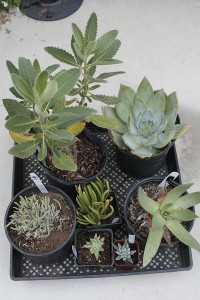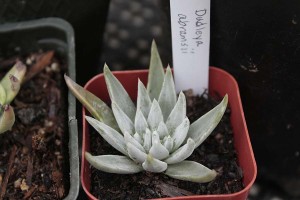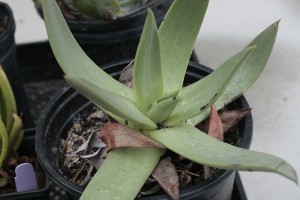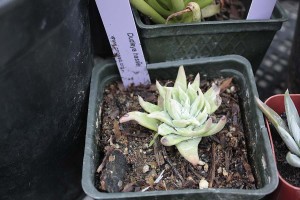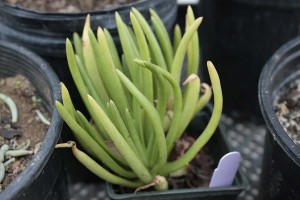Can you call a patch of dirt of about eight square feet a garden? I’m starting to consider my recent planting of succulent a miniature little dudleya patch. But a garden?
I’ve already shown off the new species I picked up at my recent native plant society’s sale. Recently I finally got around to giving them their place in the larger garden. The location is more shade than I’d like–maybe four to six hours’ sun with afternoon shade. Situated on the edge of a somewhat irrigated area devoted to fruit trees it might be more moisture than the plants really want. Most of what I’ve read about dudleyas suggests using an inorganic mulch like pebbles instead of the bark that you see here. Still, there’s an older clump of Dudleya edulis that you can see in the near-back of these photos. The clump has done well so far, so there’s hope for the new arrivals.
There are eight Dudleya species in this area of the garden, but they get to share space with a couple other other succulents, a blackish-purple aeonium and the blue chalk fingers plant (Selecio mandraliscae) that is getting to be pretty popular down here as a groundcover. The finger-shaped leaves play nice with the fingers of several of the dudleyas most easily seen in the upper left picture: edulis, viscida, and attenuata.
In the center of the space is this ornate column made out of cast concrete. The previous owners of the house must have gotten a good price on architectural molds because there’s this little column, and another, much larger, outdoor feature that looks like part of a Doric column. Either the owners were of…um, eclectic?…taste or they were postmodern two decades before Charles Moore designed the Piazza d’Italia in New Orleans. The features are made of concrete, however, so it’s a little hard to do much more than try to live with them. Maybe one day I’ll bring the diamond-bladed saw to deal with this feature. Still, living with other people’s choices can sometimes push you towards a solution you never would have come up with yourself.
So, what to do with this column in the Dudleya Garden? One obvious thing would be to place on top of it a mirrored reflecting ball, sort of a garden gazing ball that was popularized in Victorian times. I want to be a little more subversive, though. How would a bowling ball hold up to the elements? I wonder. But for now I’m auditioning a couple of rocks, an irregular chuck of green stone that John picked up somewhere, and a rounded river rock of the sort that you dig up in gardens in my neighborhood, remnants from the days when this land lay many hundred miles to the south in what’s now Mexico, days when the land was lower and drained the big river that formed the area’s Copper Canyons.
In a rock wall about fifteen feet away I had space for a single plant. This will best represent how many dudleyas are found in nature: on steep ground, often growing out of what looks like no soil at all. This is Dudleya virens ssp. hassei, a species found only on Santa Catalina Island. While some dudleya species will form a single, perfect rosette, this single growth should before too long develop into an ever-widening clump of starry foliage.
This little planting in the rocks should soon look a little like something you’d find in nature. But the other patch of dudleyas with maybe a mirrored disco ball? Well, that’s definitely going to be a human-created garden.







